Bachelor of Nursing
VerifiedAdded on 2023/03/17
|7
|1933
|91
AI Summary
This study will review my learning and comprehension that would enable me to provide person-centred care. This reflection would be in accordance with the Gibbs Reflective Cycles and will examine my understanding of the biological and psychological factors in the Roper, Logan and Tierney’s model of care, and the Clinical Reasoning Cycle.
Contribute Materials
Your contribution can guide someone’s learning journey. Share your
documents today.
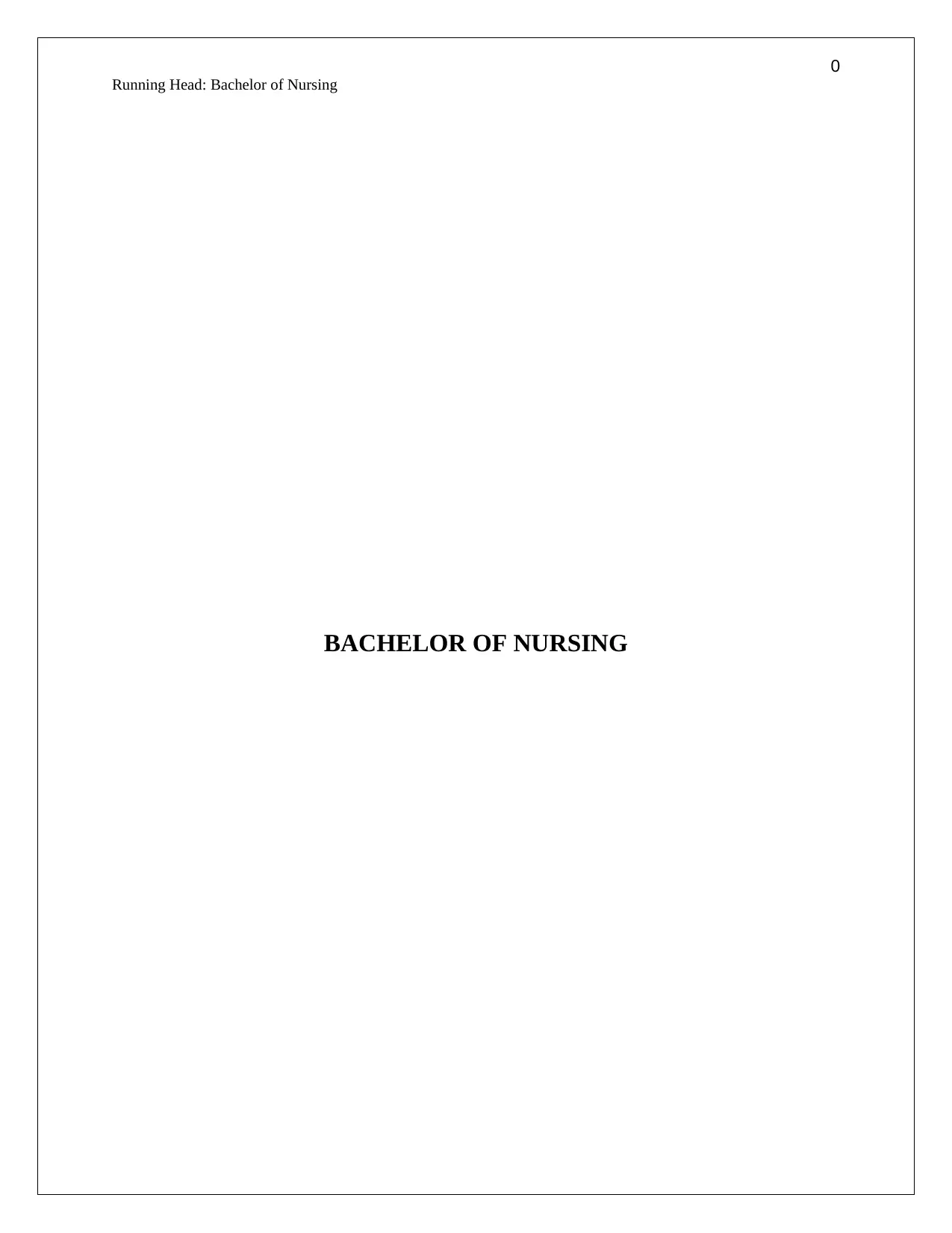
0
Running Head: Bachelor of Nursing
BACHELOR OF NURSING
Running Head: Bachelor of Nursing
BACHELOR OF NURSING
Secure Best Marks with AI Grader
Need help grading? Try our AI Grader for instant feedback on your assignments.
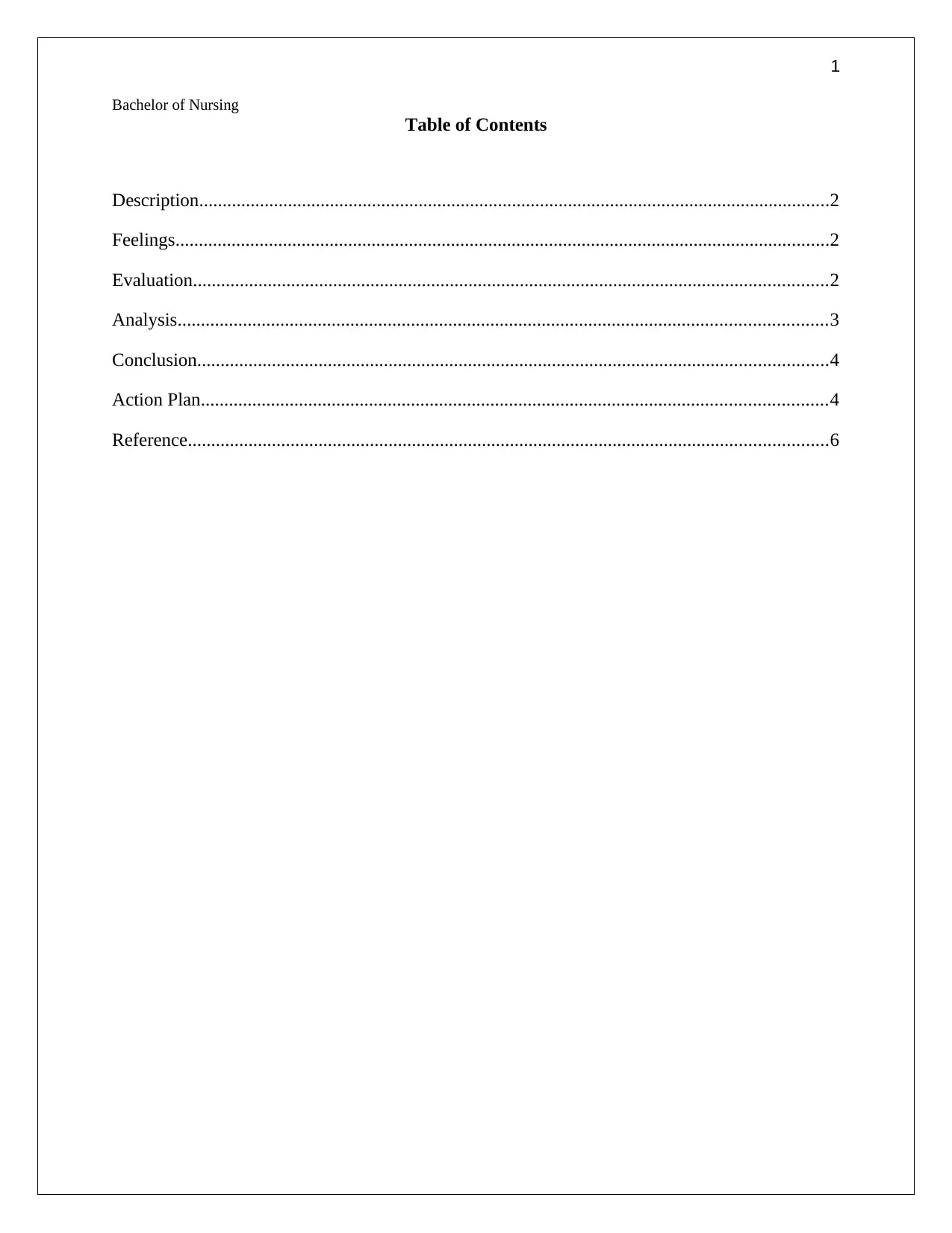
1
Bachelor of Nursing
Table of Contents
Description.......................................................................................................................................2
Feelings............................................................................................................................................2
Evaluation........................................................................................................................................2
Analysis...........................................................................................................................................3
Conclusion.......................................................................................................................................4
Action Plan......................................................................................................................................4
Reference.........................................................................................................................................6
Bachelor of Nursing
Table of Contents
Description.......................................................................................................................................2
Feelings............................................................................................................................................2
Evaluation........................................................................................................................................2
Analysis...........................................................................................................................................3
Conclusion.......................................................................................................................................4
Action Plan......................................................................................................................................4
Reference.........................................................................................................................................6
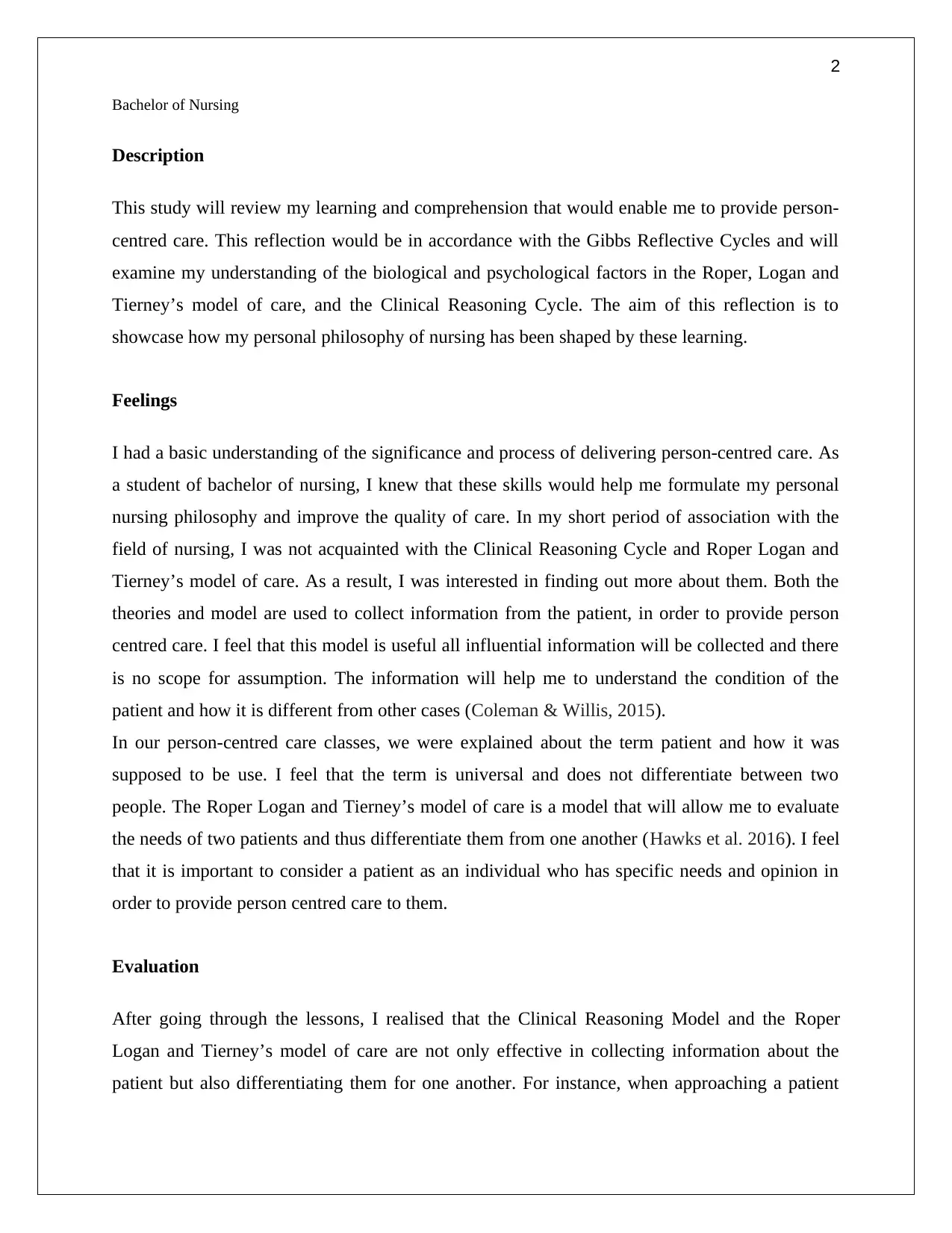
2
Bachelor of Nursing
Description
This study will review my learning and comprehension that would enable me to provide person-
centred care. This reflection would be in accordance with the Gibbs Reflective Cycles and will
examine my understanding of the biological and psychological factors in the Roper, Logan and
Tierney’s model of care, and the Clinical Reasoning Cycle. The aim of this reflection is to
showcase how my personal philosophy of nursing has been shaped by these learning.
Feelings
I had a basic understanding of the significance and process of delivering person-centred care. As
a student of bachelor of nursing, I knew that these skills would help me formulate my personal
nursing philosophy and improve the quality of care. In my short period of association with the
field of nursing, I was not acquainted with the Clinical Reasoning Cycle and Roper Logan and
Tierney’s model of care. As a result, I was interested in finding out more about them. Both the
theories and model are used to collect information from the patient, in order to provide person
centred care. I feel that this model is useful all influential information will be collected and there
is no scope for assumption. The information will help me to understand the condition of the
patient and how it is different from other cases (Coleman & Willis, 2015).
In our person-centred care classes, we were explained about the term patient and how it was
supposed to be use. I feel that the term is universal and does not differentiate between two
people. The Roper Logan and Tierney’s model of care is a model that will allow me to evaluate
the needs of two patients and thus differentiate them from one another (Hawks et al. 2016). I feel
that it is important to consider a patient as an individual who has specific needs and opinion in
order to provide person centred care to them.
Evaluation
After going through the lessons, I realised that the Clinical Reasoning Model and the Roper
Logan and Tierney’s model of care are not only effective in collecting information about the
patient but also differentiating them for one another. For instance, when approaching a patient
Bachelor of Nursing
Description
This study will review my learning and comprehension that would enable me to provide person-
centred care. This reflection would be in accordance with the Gibbs Reflective Cycles and will
examine my understanding of the biological and psychological factors in the Roper, Logan and
Tierney’s model of care, and the Clinical Reasoning Cycle. The aim of this reflection is to
showcase how my personal philosophy of nursing has been shaped by these learning.
Feelings
I had a basic understanding of the significance and process of delivering person-centred care. As
a student of bachelor of nursing, I knew that these skills would help me formulate my personal
nursing philosophy and improve the quality of care. In my short period of association with the
field of nursing, I was not acquainted with the Clinical Reasoning Cycle and Roper Logan and
Tierney’s model of care. As a result, I was interested in finding out more about them. Both the
theories and model are used to collect information from the patient, in order to provide person
centred care. I feel that this model is useful all influential information will be collected and there
is no scope for assumption. The information will help me to understand the condition of the
patient and how it is different from other cases (Coleman & Willis, 2015).
In our person-centred care classes, we were explained about the term patient and how it was
supposed to be use. I feel that the term is universal and does not differentiate between two
people. The Roper Logan and Tierney’s model of care is a model that will allow me to evaluate
the needs of two patients and thus differentiate them from one another (Hawks et al. 2016). I feel
that it is important to consider a patient as an individual who has specific needs and opinion in
order to provide person centred care to them.
Evaluation
After going through the lessons, I realised that the Clinical Reasoning Model and the Roper
Logan and Tierney’s model of care are not only effective in collecting information about the
patient but also differentiating them for one another. For instance, when approaching a patient
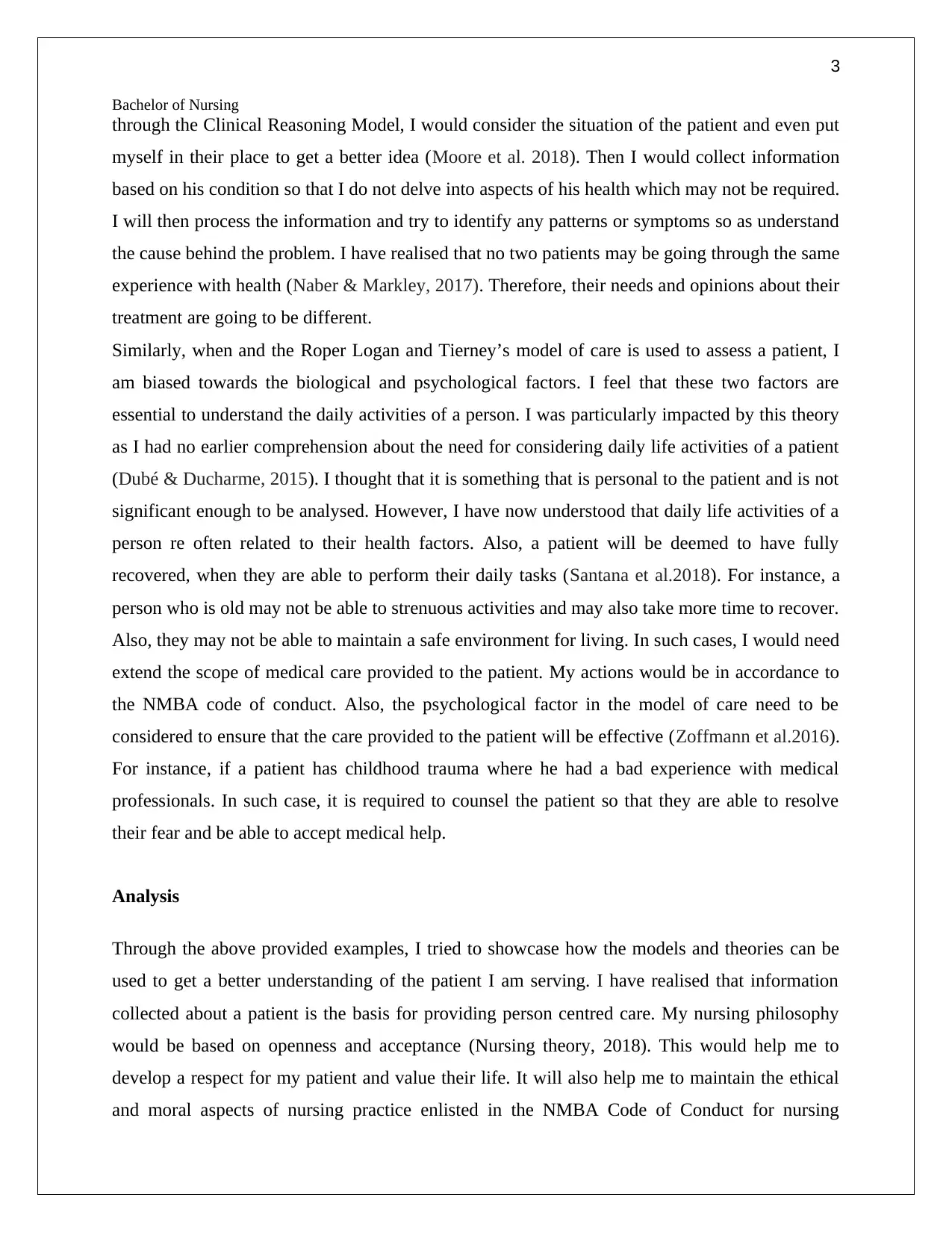
3
Bachelor of Nursing
through the Clinical Reasoning Model, I would consider the situation of the patient and even put
myself in their place to get a better idea (Moore et al. 2018). Then I would collect information
based on his condition so that I do not delve into aspects of his health which may not be required.
I will then process the information and try to identify any patterns or symptoms so as understand
the cause behind the problem. I have realised that no two patients may be going through the same
experience with health (Naber & Markley, 2017). Therefore, their needs and opinions about their
treatment are going to be different.
Similarly, when and the Roper Logan and Tierney’s model of care is used to assess a patient, I
am biased towards the biological and psychological factors. I feel that these two factors are
essential to understand the daily activities of a person. I was particularly impacted by this theory
as I had no earlier comprehension about the need for considering daily life activities of a patient
(Dubé & Ducharme, 2015). I thought that it is something that is personal to the patient and is not
significant enough to be analysed. However, I have now understood that daily life activities of a
person re often related to their health factors. Also, a patient will be deemed to have fully
recovered, when they are able to perform their daily tasks (Santana et al.2018). For instance, a
person who is old may not be able to strenuous activities and may also take more time to recover.
Also, they may not be able to maintain a safe environment for living. In such cases, I would need
extend the scope of medical care provided to the patient. My actions would be in accordance to
the NMBA code of conduct. Also, the psychological factor in the model of care need to be
considered to ensure that the care provided to the patient will be effective (Zoffmann et al.2016).
For instance, if a patient has childhood trauma where he had a bad experience with medical
professionals. In such case, it is required to counsel the patient so that they are able to resolve
their fear and be able to accept medical help.
Analysis
Through the above provided examples, I tried to showcase how the models and theories can be
used to get a better understanding of the patient I am serving. I have realised that information
collected about a patient is the basis for providing person centred care. My nursing philosophy
would be based on openness and acceptance (Nursing theory, 2018). This would help me to
develop a respect for my patient and value their life. It will also help me to maintain the ethical
and moral aspects of nursing practice enlisted in the NMBA Code of Conduct for nursing
Bachelor of Nursing
through the Clinical Reasoning Model, I would consider the situation of the patient and even put
myself in their place to get a better idea (Moore et al. 2018). Then I would collect information
based on his condition so that I do not delve into aspects of his health which may not be required.
I will then process the information and try to identify any patterns or symptoms so as understand
the cause behind the problem. I have realised that no two patients may be going through the same
experience with health (Naber & Markley, 2017). Therefore, their needs and opinions about their
treatment are going to be different.
Similarly, when and the Roper Logan and Tierney’s model of care is used to assess a patient, I
am biased towards the biological and psychological factors. I feel that these two factors are
essential to understand the daily activities of a person. I was particularly impacted by this theory
as I had no earlier comprehension about the need for considering daily life activities of a patient
(Dubé & Ducharme, 2015). I thought that it is something that is personal to the patient and is not
significant enough to be analysed. However, I have now understood that daily life activities of a
person re often related to their health factors. Also, a patient will be deemed to have fully
recovered, when they are able to perform their daily tasks (Santana et al.2018). For instance, a
person who is old may not be able to strenuous activities and may also take more time to recover.
Also, they may not be able to maintain a safe environment for living. In such cases, I would need
extend the scope of medical care provided to the patient. My actions would be in accordance to
the NMBA code of conduct. Also, the psychological factor in the model of care need to be
considered to ensure that the care provided to the patient will be effective (Zoffmann et al.2016).
For instance, if a patient has childhood trauma where he had a bad experience with medical
professionals. In such case, it is required to counsel the patient so that they are able to resolve
their fear and be able to accept medical help.
Analysis
Through the above provided examples, I tried to showcase how the models and theories can be
used to get a better understanding of the patient I am serving. I have realised that information
collected about a patient is the basis for providing person centred care. My nursing philosophy
would be based on openness and acceptance (Nursing theory, 2018). This would help me to
develop a respect for my patient and value their life. It will also help me to maintain the ethical
and moral aspects of nursing practice enlisted in the NMBA Code of Conduct for nursing
Secure Best Marks with AI Grader
Need help grading? Try our AI Grader for instant feedback on your assignments.
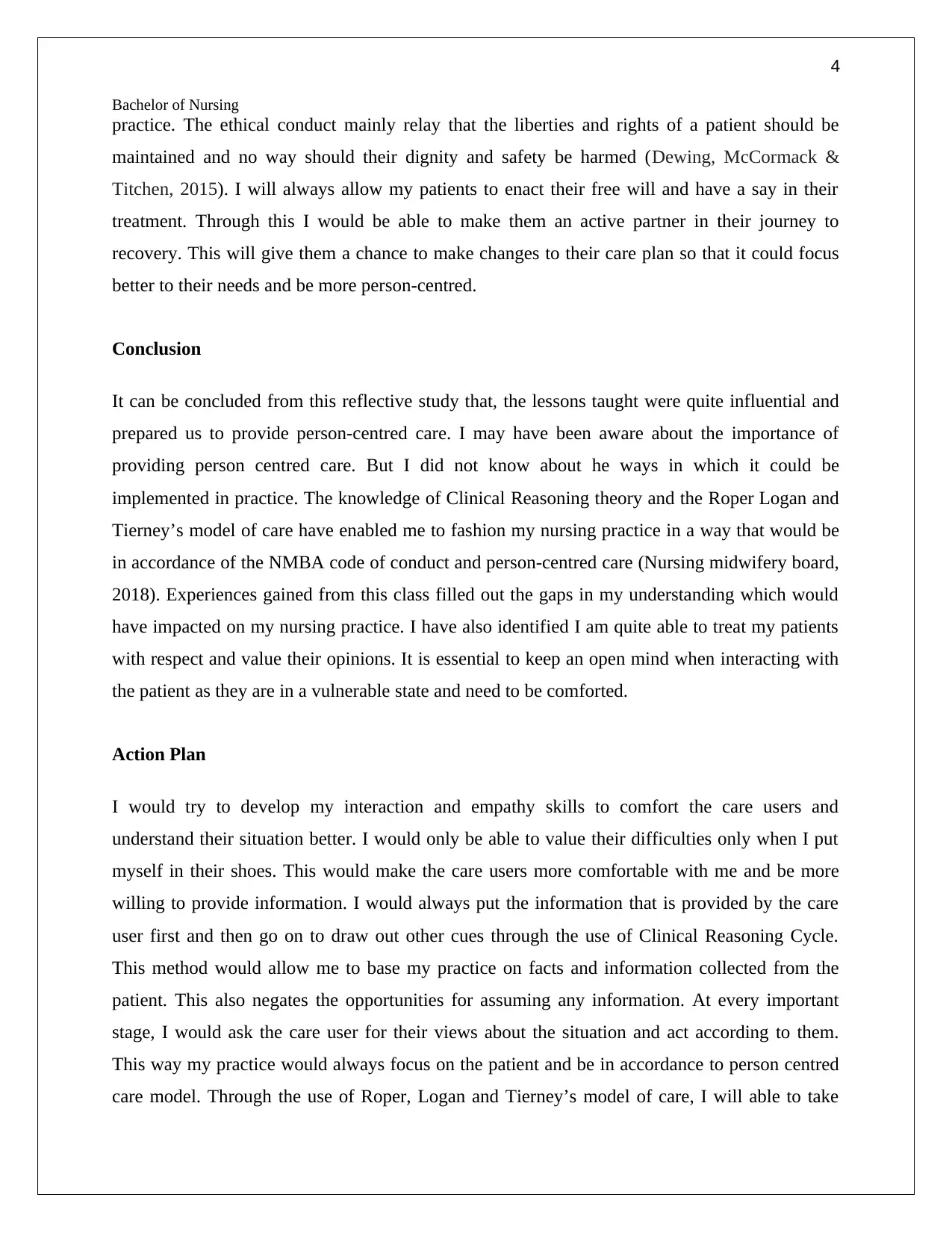
4
Bachelor of Nursing
practice. The ethical conduct mainly relay that the liberties and rights of a patient should be
maintained and no way should their dignity and safety be harmed (Dewing, McCormack &
Titchen, 2015). I will always allow my patients to enact their free will and have a say in their
treatment. Through this I would be able to make them an active partner in their journey to
recovery. This will give them a chance to make changes to their care plan so that it could focus
better to their needs and be more person-centred.
Conclusion
It can be concluded from this reflective study that, the lessons taught were quite influential and
prepared us to provide person-centred care. I may have been aware about the importance of
providing person centred care. But I did not know about he ways in which it could be
implemented in practice. The knowledge of Clinical Reasoning theory and the Roper Logan and
Tierney’s model of care have enabled me to fashion my nursing practice in a way that would be
in accordance of the NMBA code of conduct and person-centred care (Nursing midwifery board,
2018). Experiences gained from this class filled out the gaps in my understanding which would
have impacted on my nursing practice. I have also identified I am quite able to treat my patients
with respect and value their opinions. It is essential to keep an open mind when interacting with
the patient as they are in a vulnerable state and need to be comforted.
Action Plan
I would try to develop my interaction and empathy skills to comfort the care users and
understand their situation better. I would only be able to value their difficulties only when I put
myself in their shoes. This would make the care users more comfortable with me and be more
willing to provide information. I would always put the information that is provided by the care
user first and then go on to draw out other cues through the use of Clinical Reasoning Cycle.
This method would allow me to base my practice on facts and information collected from the
patient. This also negates the opportunities for assuming any information. At every important
stage, I would ask the care user for their views about the situation and act according to them.
This way my practice would always focus on the patient and be in accordance to person centred
care model. Through the use of Roper, Logan and Tierney’s model of care, I will able to take
Bachelor of Nursing
practice. The ethical conduct mainly relay that the liberties and rights of a patient should be
maintained and no way should their dignity and safety be harmed (Dewing, McCormack &
Titchen, 2015). I will always allow my patients to enact their free will and have a say in their
treatment. Through this I would be able to make them an active partner in their journey to
recovery. This will give them a chance to make changes to their care plan so that it could focus
better to their needs and be more person-centred.
Conclusion
It can be concluded from this reflective study that, the lessons taught were quite influential and
prepared us to provide person-centred care. I may have been aware about the importance of
providing person centred care. But I did not know about he ways in which it could be
implemented in practice. The knowledge of Clinical Reasoning theory and the Roper Logan and
Tierney’s model of care have enabled me to fashion my nursing practice in a way that would be
in accordance of the NMBA code of conduct and person-centred care (Nursing midwifery board,
2018). Experiences gained from this class filled out the gaps in my understanding which would
have impacted on my nursing practice. I have also identified I am quite able to treat my patients
with respect and value their opinions. It is essential to keep an open mind when interacting with
the patient as they are in a vulnerable state and need to be comforted.
Action Plan
I would try to develop my interaction and empathy skills to comfort the care users and
understand their situation better. I would only be able to value their difficulties only when I put
myself in their shoes. This would make the care users more comfortable with me and be more
willing to provide information. I would always put the information that is provided by the care
user first and then go on to draw out other cues through the use of Clinical Reasoning Cycle.
This method would allow me to base my practice on facts and information collected from the
patient. This also negates the opportunities for assuming any information. At every important
stage, I would ask the care user for their views about the situation and act according to them.
This way my practice would always focus on the patient and be in accordance to person centred
care model. Through the use of Roper, Logan and Tierney’s model of care, I will able to take
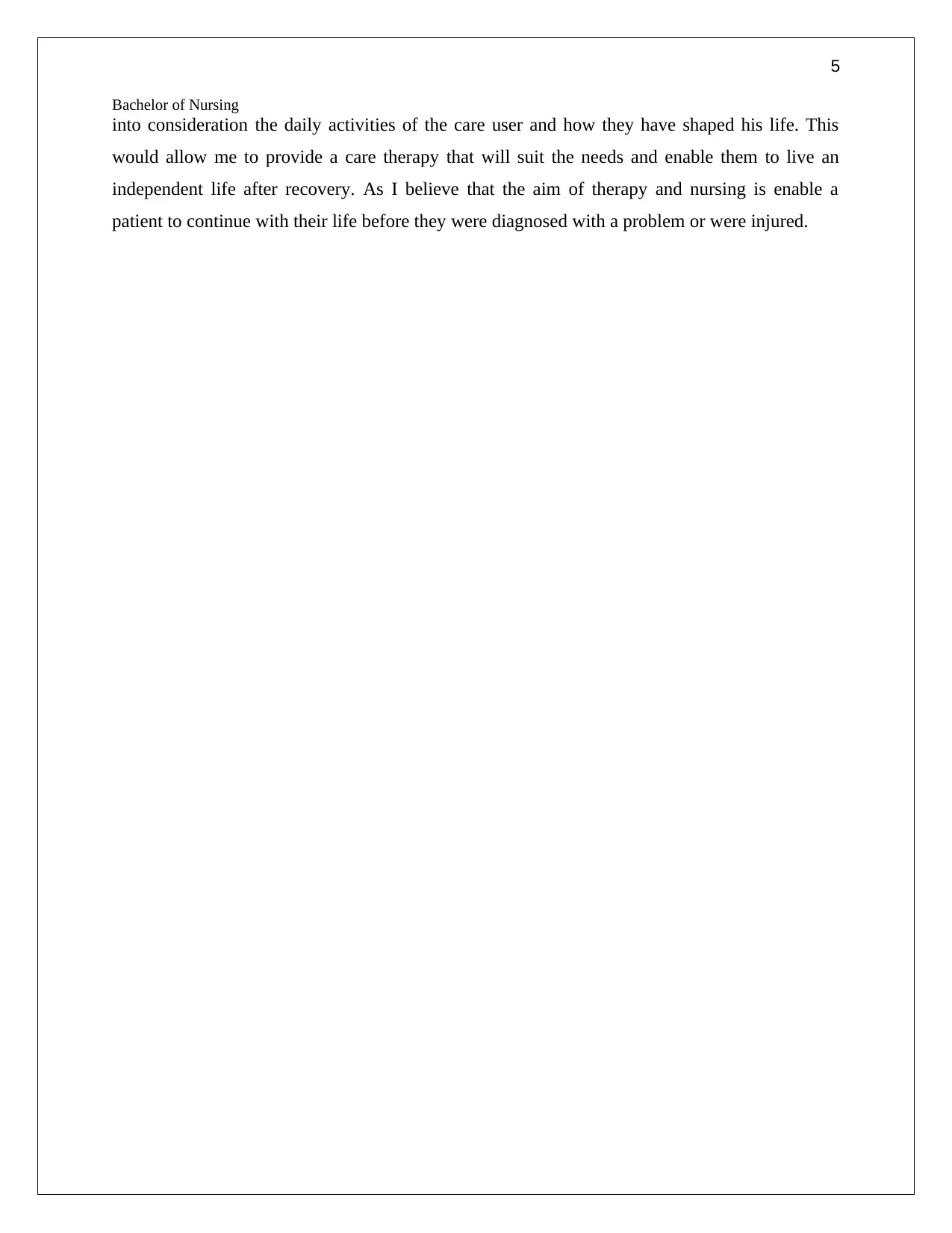
5
Bachelor of Nursing
into consideration the daily activities of the care user and how they have shaped his life. This
would allow me to provide a care therapy that will suit the needs and enable them to live an
independent life after recovery. As I believe that the aim of therapy and nursing is enable a
patient to continue with their life before they were diagnosed with a problem or were injured.
Bachelor of Nursing
into consideration the daily activities of the care user and how they have shaped his life. This
would allow me to provide a care therapy that will suit the needs and enable them to live an
independent life after recovery. As I believe that the aim of therapy and nursing is enable a
patient to continue with their life before they were diagnosed with a problem or were injured.
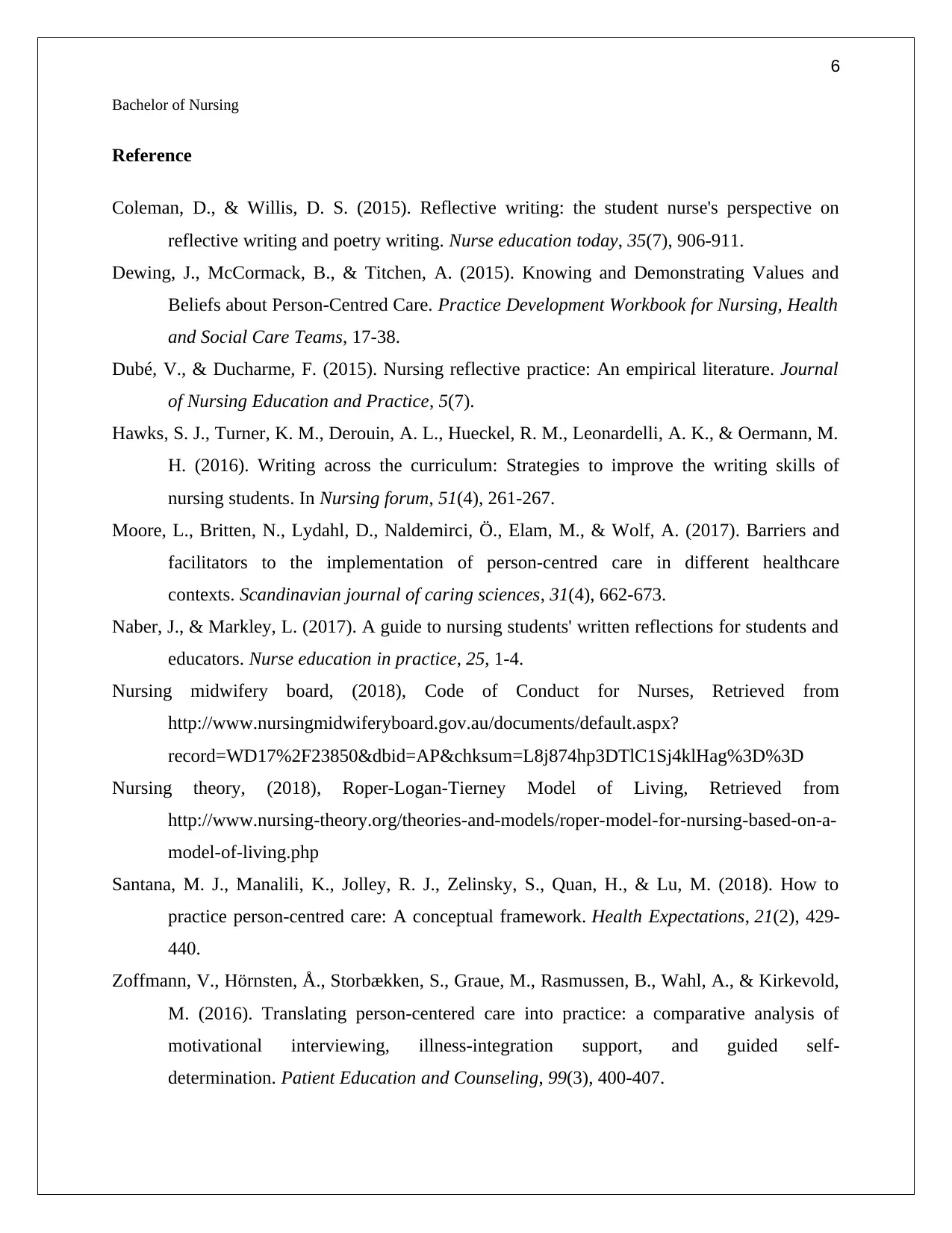
6
Bachelor of Nursing
Reference
Coleman, D., & Willis, D. S. (2015). Reflective writing: the student nurse's perspective on
reflective writing and poetry writing. Nurse education today, 35(7), 906-911.
Dewing, J., McCormack, B., & Titchen, A. (2015). Knowing and Demonstrating Values and
Beliefs about Person‐Centred Care. Practice Development Workbook for Nursing, Health
and Social Care Teams, 17-38.
Dubé, V., & Ducharme, F. (2015). Nursing reflective practice: An empirical literature. Journal
of Nursing Education and Practice, 5(7).
Hawks, S. J., Turner, K. M., Derouin, A. L., Hueckel, R. M., Leonardelli, A. K., & Oermann, M.
H. (2016). Writing across the curriculum: Strategies to improve the writing skills of
nursing students. In Nursing forum, 51(4), 261-267.
Moore, L., Britten, N., Lydahl, D., Naldemirci, Ö., Elam, M., & Wolf, A. (2017). Barriers and
facilitators to the implementation of person‐centred care in different healthcare
contexts. Scandinavian journal of caring sciences, 31(4), 662-673.
Naber, J., & Markley, L. (2017). A guide to nursing students' written reflections for students and
educators. Nurse education in practice, 25, 1-4.
Nursing midwifery board, (2018), Code of Conduct for Nurses, Retrieved from
http://www.nursingmidwiferyboard.gov.au/documents/default.aspx?
record=WD17%2F23850&dbid=AP&chksum=L8j874hp3DTlC1Sj4klHag%3D%3D
Nursing theory, (2018), Roper-Logan-Tierney Model of Living, Retrieved from
http://www.nursing-theory.org/theories-and-models/roper-model-for-nursing-based-on-a-
model-of-living.php
Santana, M. J., Manalili, K., Jolley, R. J., Zelinsky, S., Quan, H., & Lu, M. (2018). How to
practice person‐centred care: A conceptual framework. Health Expectations, 21(2), 429-
440.
Zoffmann, V., Hörnsten, Å., Storbækken, S., Graue, M., Rasmussen, B., Wahl, A., & Kirkevold,
M. (2016). Translating person-centered care into practice: a comparative analysis of
motivational interviewing, illness-integration support, and guided self-
determination. Patient Education and Counseling, 99(3), 400-407.
Bachelor of Nursing
Reference
Coleman, D., & Willis, D. S. (2015). Reflective writing: the student nurse's perspective on
reflective writing and poetry writing. Nurse education today, 35(7), 906-911.
Dewing, J., McCormack, B., & Titchen, A. (2015). Knowing and Demonstrating Values and
Beliefs about Person‐Centred Care. Practice Development Workbook for Nursing, Health
and Social Care Teams, 17-38.
Dubé, V., & Ducharme, F. (2015). Nursing reflective practice: An empirical literature. Journal
of Nursing Education and Practice, 5(7).
Hawks, S. J., Turner, K. M., Derouin, A. L., Hueckel, R. M., Leonardelli, A. K., & Oermann, M.
H. (2016). Writing across the curriculum: Strategies to improve the writing skills of
nursing students. In Nursing forum, 51(4), 261-267.
Moore, L., Britten, N., Lydahl, D., Naldemirci, Ö., Elam, M., & Wolf, A. (2017). Barriers and
facilitators to the implementation of person‐centred care in different healthcare
contexts. Scandinavian journal of caring sciences, 31(4), 662-673.
Naber, J., & Markley, L. (2017). A guide to nursing students' written reflections for students and
educators. Nurse education in practice, 25, 1-4.
Nursing midwifery board, (2018), Code of Conduct for Nurses, Retrieved from
http://www.nursingmidwiferyboard.gov.au/documents/default.aspx?
record=WD17%2F23850&dbid=AP&chksum=L8j874hp3DTlC1Sj4klHag%3D%3D
Nursing theory, (2018), Roper-Logan-Tierney Model of Living, Retrieved from
http://www.nursing-theory.org/theories-and-models/roper-model-for-nursing-based-on-a-
model-of-living.php
Santana, M. J., Manalili, K., Jolley, R. J., Zelinsky, S., Quan, H., & Lu, M. (2018). How to
practice person‐centred care: A conceptual framework. Health Expectations, 21(2), 429-
440.
Zoffmann, V., Hörnsten, Å., Storbækken, S., Graue, M., Rasmussen, B., Wahl, A., & Kirkevold,
M. (2016). Translating person-centered care into practice: a comparative analysis of
motivational interviewing, illness-integration support, and guided self-
determination. Patient Education and Counseling, 99(3), 400-407.
1 out of 7
Related Documents
Your All-in-One AI-Powered Toolkit for Academic Success.
+13062052269
info@desklib.com
Available 24*7 on WhatsApp / Email
![[object Object]](/_next/static/media/star-bottom.7253800d.svg)
Unlock your academic potential
© 2024 | Zucol Services PVT LTD | All rights reserved.




